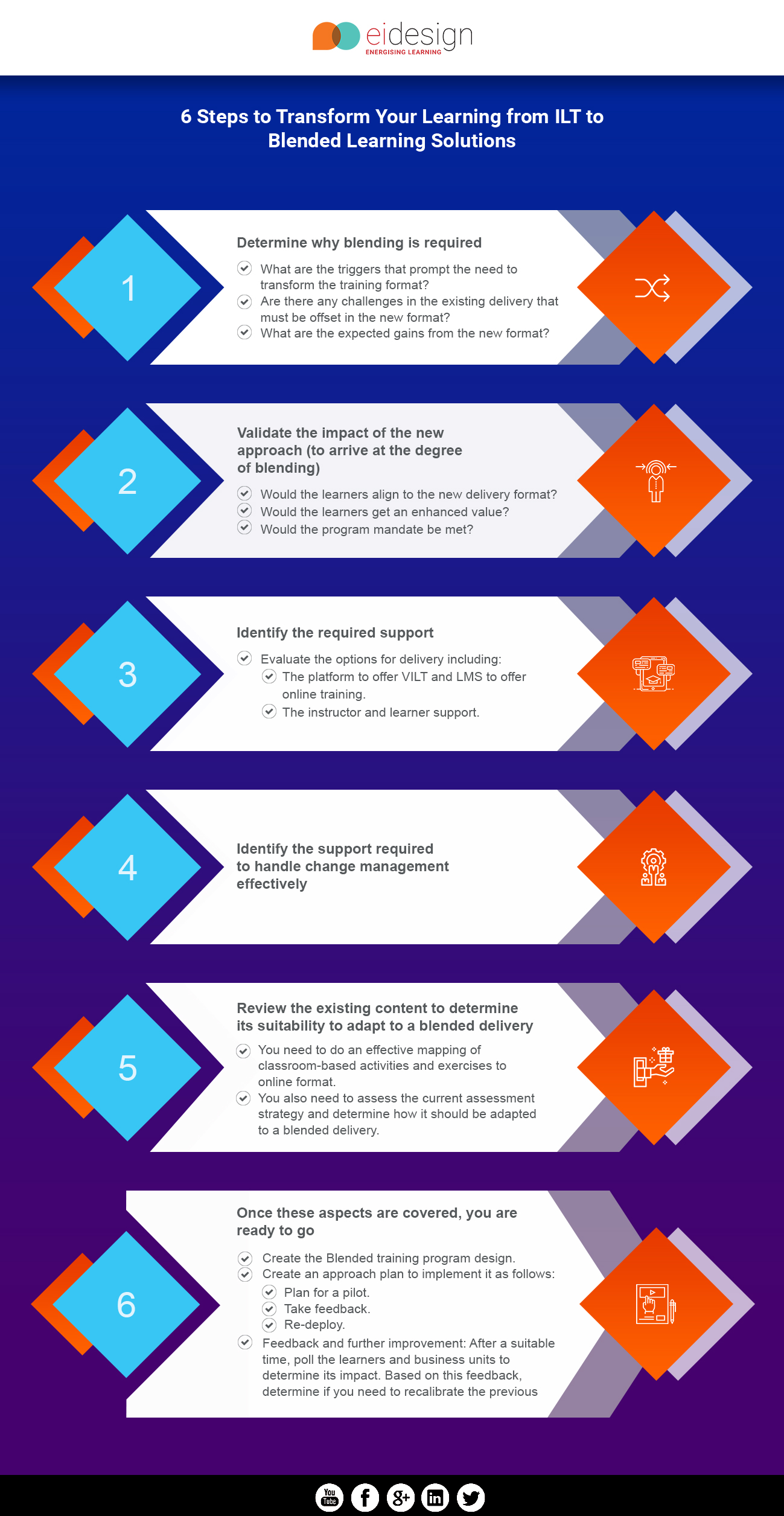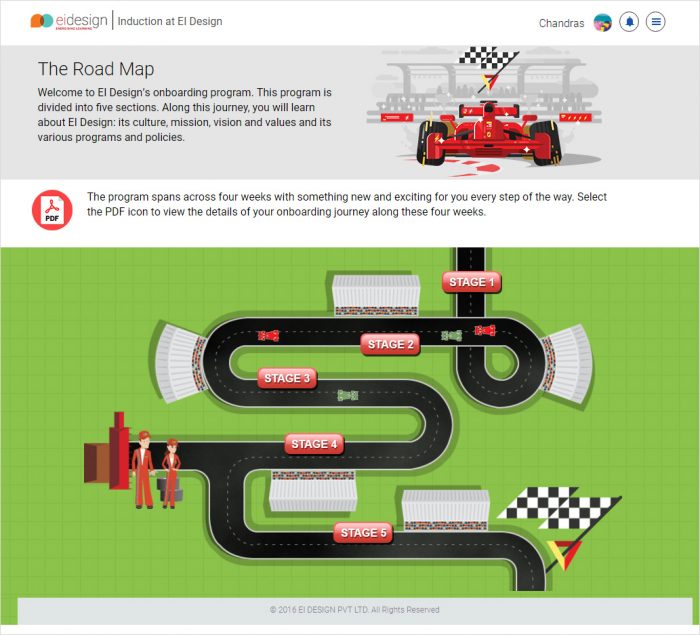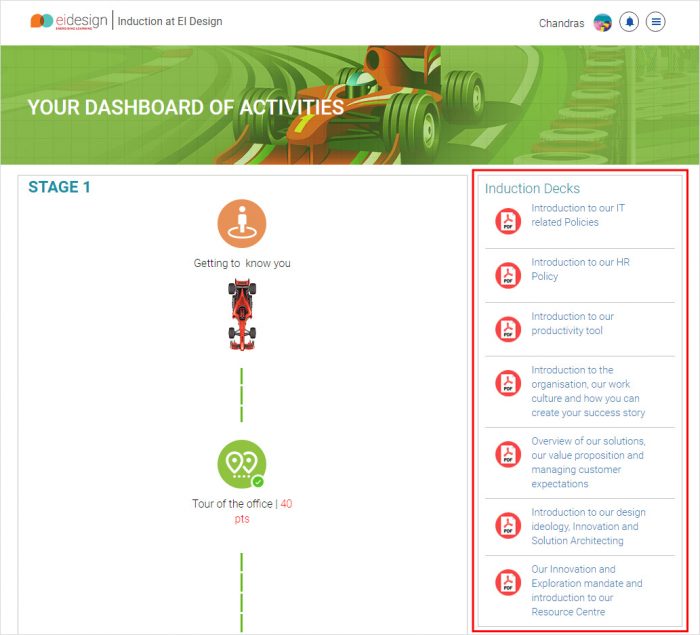In this article, I share a guide that you can use as you embark on the conversion of Instructor-Led Training (ILT) to blended learning solutions. These pointers will help you create high-impact blended learning programs and a positive ROI.
All About Blended Learning Solutions
Before I outline the step-by-step guide that you can use to convert your ILT programs to effective blended learning solutions, let me touch upon a few essentials.
What Are Blended Learning Solutions?
Blended learning solutions offer the optimal combination of a classic form of training (ILT) and self-paced online training (eLearning or mobile learning).
- The degree of the blend is primarily decided by looking at the nature of the content and how learners respond to the mixed mode.
- Additionally, you need to look at the readiness of technology and deployment.
- Finally, you need to have adequate support measures to support the learners as well as the trainers through the transition of the facilitated mode to blended learning solutions.
What Is Triggering A Wider Adoption Of Blended Learning Solutions Over Instructor-Led Training Or ILT?
From an organizational perspective, we see the following triggers:
- Cost reduction
- Need to reach a wider audience in a shorter time with a consistent message
- Ability to update and redeploy training in a short time
From the learners’ perspective, the primary trigger is the flexibility that blended learning solutions offer (to take the training at their own pace, and when they want it).
What Are The Key Benefits That Learners And Organizations Gain If They Adopt A Blended Learning Solution Over A Traditional ILT?
Here is a summary of the key benefits:
Benefits For The Learners
- Blended learning solutions are learner-centric, and the online component provides control to the learners to set and manage their pace of learning.
- Learners have now access to online resources that they can refer to easily after the facilitated program is over.
- Research shows that learners show higher retention levels with blended learning solutions as compared to a fully facilitated session. This goes a long way in positively impacting ROI.
- The blended learning solutions are designed to offer continued interaction with trainers as well as peers, thereby keeping learning to be continuous.
Benefits For The Organizations
- Cost reduction and lesser seat time, compared to a fully facilitated training.
- Ability to reach a wider audience in a shorter time with a consistent message.
- Organizations can tap into more immersive online learning strategies (including mobile learning, microlearning, gamification, video-based learning, and social learning to name a few) that resonate well with learners and create a more sticky learning experience.
- Ability to update and redeploy training in a short time.
- Trainers can ascertain the progress quickly through online assessments and, if required, plan for tweaks or further interventions.
Are There Any Challenges That You Should Watch Out For As You Opt For A Blended Learning Solution?
While blended learning solutions offer several benefits as outlines, in our experience, the transition process throws up the following challenges:
- Not quite sure where to begin
- No buy-in from senior stakeholders
- Lack of adequate resources to manage the transition
- Trainers may have reservations on updating the curriculum from a fully facilitated mode to a blended learning mode
- Lack of complete understanding on the right degree of the blend to create an optimal blended learning solution
How Can Our Guide Assist You In Managing The Transformation From ILT To Creating Highly Effective Blended Learning Solutions?
At EI Design, our practice of blended training delivery is a mature one. We recognize that arriving at the solution that would work for a given program is both art and science. I share our practical, step-by-step guide that you can use when adopting blended training, particularly for the first time.
Step 1: Determine Why Blending Is Required
- What are the triggers that prompt the need to transform the training format?
- Are there any challenges in the existing delivery that must be offset in the new format?
- What are the expected gains from the new format?
Step 2: Validate The Impact Of The New Approach (To Arrive At The Degree Of Blending)
- Would learners align to the new delivery format?
- Would learners get an enhanced value?
- Would the program mandate be met?
Step 3: Identify The Required Support
- Evaluate the options for delivery including:
– The platform to offer VILT and LMS to offer online training
– The instructor and learner support
Step 4: Identify The Support Required To Handle Change Management Effectively
Step 5: Review The Existing Content To Determine Its Suitability To Adapt To A Blended Delivery
- You need to do an effective mapping of classroom-based activities and exercises to an online format.
- You also need to assess the current assessment strategy and determine how it should be adapted to a blended delivery.
Step 6: Once These Aspects Are Covered, You Are Ready To Go
- Create the blended training program design.
- Create an approach plan to implement it as follows:
– Plan for a pilot
– Take feedback
– Redeploy - Feedback and further improvement: After a suitable time, poll the learners and business units to determine its impact. Based on this feedback, determine if you need to recalibrate the previous blend.

I hope this article provides practical pointers that you can use as you move from a fully facilitated, ILT program to a blended learning solution.
If you have any specific queries, do contact me or leave a comment below.
Source: https://www.eidesign.net/a-complete-guide-on-blended-learning-solutions/


